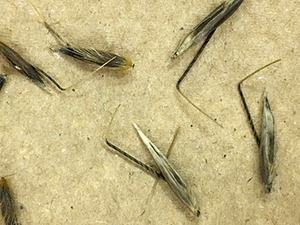
Know Your Enemy: Wild Oat Biology
By Kaeley Kindrachuk, B.App.Sc., TechAg, Crops Extension Specialist and Clark Brenzil, PAg, Provincial Specialist, Weed Control
Wild oats are not a new weed to Saskatchewan. In surveys conducted in the province dating back to 1983, wild oat has consistently ranked one of the top five weeds found in the province. Because producers have been controlling wild oats for many years by relying heavily on herbicides, herbicide resistance in this weed is increasing. While the last complete herbicide resistance survey was conducted in the 2014-

15 growing seasons, another survey cycle has begun with southern Saskatchewan surveyed in 2019 and northern Saskatchewan to be surveyed in 2020. Herbicide resistance surveys will also be conducted at the same time on a subset of the more than 2,100 fields in the main survey. Knowing a bit about the weed you are dealing with and whether or not it is resistant to particular herbicides will go a long way in being able to control it, thus improving your crop’s overall plant health.
Wild oats (like most temperate plants) have a C3 metabolism, which means they are more efficient at photosynthesis in cooler, wet climates. C3 plants also have a lower optimum temperature than C4 plants (corn, kochia, etc.). C4 plants have an additional pathway in them that allows them to tolerate hot, dry conditions. This draws on more resources from the plant than the C3 plants have to worry about. Under cooler climates, C4 plants are at a disadvantage; in warmer climates, however, this additional pathway creates an advantage.
The conditions required for wild oats to germinate can range based on the following:
- Temperature/timing: The optimum temperature for wild oats to germinate is 5 to 20 C. Wild oat germination will decrease at temperatures greater than 20 C. Fluctuating day-night temperatures are needed to mimic nature and start germination. Germination won’t occur at soil temperatures below 5 C. Wild oats usually emerge in early spring, particularly mid-April to mid-May, although they may still emerge throughout the growing season.
- Seed depth: The most successful germination will occur at seed depths of five to 20 cm, with reduced success at less than five cm and deeper than 20 cm. Germination requires a dormant period, and no germination will occur if the seeds are exposed to light.
- Longevity: Seeds are usually viable for four to five years in lighter soils, but can remain viable for up to nine years in heavier clay soils. Per cent viability of the seed drops quickly following the year following seed shed.
- Plant characteristics: Wild oats have an unusual process of self-burial, where the seeds will bury themselves into the ground. When seeds are moistened, the awn unwinds; when it dries, the awn will twist again. Backward-pointing hairs on the seed allow the seed to move in only one direction.
Considerations for control with herbicides include the following:
- Timing: Wild oats can be managed by using burndown, soil-active and foliar in-crop herbicides. The earlier wild oats are controlled; the less negative competition impact they exert on crops. For example, a modest population of 40 wild oat plants per square metre caused 32 per cent yield loss when they emerged one day before a wheat crop, 20 per cent yield loss emerging the same day as wheat and only eight per cent loss when emerging a day after wheat.
When controlling wild oats, it is important to scout before application. Depending on the product you’re using, there is a range in crop staging. Crops respond best to herbicides when applied at earlier staging; weeds emerging afterward impact the crop less than early-emerging weeds. Spraying later will control more of the weeds that emerge later, but the damage to the crop yield from weeds emerging before or with the crop will continue to mount.
Wild oats are prone to premature seed shatter earlier in the fall, so controlling this weed before it sets seed is important. The Guide to Crop Protection describes which application time ranges are best to control wild oats, depending on which herbicide you’re using. When tank mixing, be sure to follow label recommendations of all products. - Herbicide resistance: While there are still some herbicide options available for controlling wild oats, an increasing proportion of fields in Saskatchewan are evolving populations resistant to one or more herbicide modes of action, or “Groups.” Of the 400 fields surveyed in the 2014-15 herbicide-resistant weed survey, 301 had wild oat samples collected. The remainder were fields whose wild oats had already been controlled, or were free of wild oats to begin with. Of the 301 fields with wild oats, 65 per cent had a herbicide-resistant population. Group 1-resistant wild oats were confirmed in 59 per cent of the fields sampled, Group 2-resistant in 32 per cent, and wild oats resistant to both Group 1 and Group 2 were found in 25 per cent of those fields. If you suspect herbicide resistance, contact the Crop Protection Lab for more information on testing. The Crop Protection Lab offers diagnostic testing, year round, to producers and agronomists in Saskatchewan. Guidelines are highlighted for submitting weed seed samples on the Herbicide Resistance Testing web page.
Mechanical options can also be used to help control wild oat populations. When placed shallower in the soil profile, weed seeds tend to emerge in a more concentrated flush in the spring than throughout the growing season. Wild oat seeds sitting on or close to the surface are more susceptible to fluctuating temperatures and moisture levels, predation from rodents, birds or insects, fungal attacks, or fatal germination. The result is the seed bank can be reduced and less persistent. Targeted tillage may play a role in managing escaped patches suspected to be resistant, rather than reverting to a herbicide application.
Weed clipping may be effective for wild oats in shorter crops such as lentils. New research is showing that chaff mills can be effective in reducing the viability of wild oats if the seeds have not all shattered. Using side-banded fertilizer will also give the crop an advantage versus broadcasting, which gives the crop and weeds similar access to nutrients. You may also want to consider adding forages into rotation; silage or hay that cuts both forage and weeds before seed set is useful for reducing wild oat soil seed reserves.
A single wild oat plant is capable of producing up to 500 seeds (if conditions are perfect), but 100 to 150 seeds are most common, with fewer being produced if plant competition is high. It is important to control weeds early, before they set seed. Weed control should not take a “one-size-fits-all” approach. Understanding the weed population in a field and whether it is resistant to any herbicides will go a long way in managing weeds on your farm.
For more information, contact the Crop Protection Laboratory about Herbicide Resistance Testing or contact your local Crops Extension Specialist.
For the latest information and for more updates on everything Kindersley ‘Like’ the Kindersley Social Facebook page below…








































